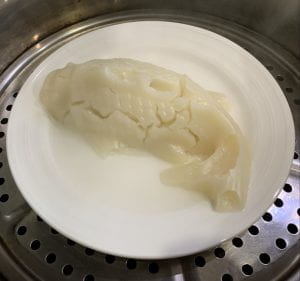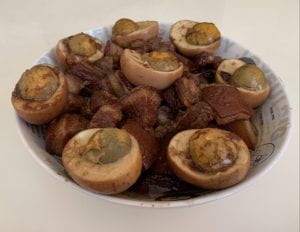General Information about Item:
- Genre: Material Lore – dish; Customary Lore – celebration, superstition, family tradition; Verbal Lore – saying
- Language: English with some Chinese (Mandarin)
- Country of Origin: China
- Informant: W.W.
- Date Collected: November 15, 2020
Informant Data:
- W.W. is a 22-year-old senior studying Mathematics and Computer Science at Dartmouth. He was born in Boulder, Colorado, but his family moved to Shanghai, China when he was 9 years old. Every summer vacation and Chinese New Year while in China, W.W. would visit his maternal relatives in Beijing with his parents and little sister. To celebrate the reunion of the extended family, his grandma would host a large dinner celebration at home with all the relatives invited, including all the uncles, aunts, cousins, and even the family pets.
Contextual Data:
Cultural Context
- “Nián gāo” (年糕) refers to Glutinous Rice Cake, but it can also be translated literally as “New Year Cake.” The name is auspicious because it sounds similar to the popular Chinese New Year’s saying “nián nián gāo” (年年高), which means “higher every year.” It is often used as a toast at the dinner table to wish good health for elders, successful careers for working adults, and stellar grades for children.
Social Context
- Glutinous Rice Cake is always served for the traditional feast on Chinese New Year’s Eve. The extended family reunites to celebrate this special occasion. After the feast, the family watches fireworks and a special show on TV called “chūn wǎn” (春晚), which features singing, dancing, and traditional performances.
Item:
- “Nián gāo” (年糕), or Glutinous Rice Cake, comes in two varieties: savory and sweet. The preparation process is straightforward but time consuming. First, boiled sticky rice is pounded into a paste and molded into dough. The dough is then cooked again, usually by steaming. Savory Glutinous Rice Cake dishes are usually served as entrées. The rice dough is cooked plain, typically in the shape of cylinders or flat slices, and subsequently stir fried with other ingredients or used in hotpot. For example, in Shanghai, Glutinous Rice Cake is often stir fried with cabbage and shredded pork. Sweet Glutinous Rice Cake dishes, on the other hand, are served as desserts. Sugar, assorted nuts, and dried fruits are added to the dough before cooking or mixed in afterwards. When purchased at the store, sweet Glutinous Rice Cake dishes are often packed in more elaborate shapes such as fish, which symbolizes surplus and unity.
Image Files:

Sweet Glutinous Rice Cake in elaborate packaging (Photo was taken by W.W.’s family members on November 7, 2020; it was ordered online.)

Sweet Glutinous Rice Cake being steamed (Photo was taken by W.W.’s family members on November 7, 2020; unfortunately the end product is not as beautiful as the packaging.)
Transcript of Interview Clip:
W.W. (collector and informant): When I was a child, um, I remember that my favorite dessert for Chinese New Year was sweet Glutinous Rice Cake shaped like koi. Since I was allergic to tree nuts, my parents and grandparents always bought it plain. The packaging was super elaborate, so I was always, um, a little, very disappointed actually, to discover that the rice cake itself was plain white. My family would steam the plain rice cake and serve it with nuts and other toppings placed separately on the side. I always struggled to eat it because it was very sticky. Apparently, the right technique is to stick your chopsticks into the rice cake and swirl them around until a decent sized blob forms. After eating the rice cake, we would cast lots to see who would clean the dishes because it was always a tedious chore to clean off the sticky remains.
Collector’s Comments:
- Talking about Glutinous Rice Cake brings back happy childhood memories and evokes a strong feeling of nostalgia. I always preferred the sweet type instead of the savory type. My parents did not have the time to make rice dough themselves, so they bought it pre-packaged from the store, usually weeks in advance. I would always beg them to let me eat it before Chinese New Year, but my efforts were never successful.
Collector’s Name: Winston Wang

